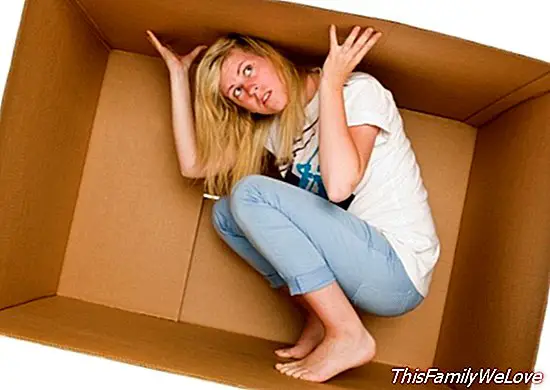Claustrophobia, how to overcome the fear of closed spaces?

Closed spaces, especially if they are small and poorly lit, can generate a certain sense of anguish. In some people, this sensation is very intense and results in an anxiety response that hinders their day to day. We talk about claustrophobia, a disorder that generates great discomfort and strong reactions of stress, anguish and despair difficult to control. The feeling of being trapped is so great that it dominates the conscience and controls the acts, becoming limiting.
What causes fear in claustrophobia?
The fear of remaining in a closed space is a very good definition for the claustrophobia, but not very precise. What really causes fear in the closed spaces? Why is this situation assessed as dangerous?
Some authors, such as Rachman and Taylor (1993), have clarified and clarified the fear of claustrophobia. The fear is not the closed space itself, but what can happen in that situation, to be perceived closed and without escape. Deepening the topic, fear focuses in two directions:
1. Fear of movement restriction. Not being able to move implies not being able to defend oneself. Fear of confinement. Not being able to leave implies not being able to escape from danger. Both fears are innate fears of the species, since they suppose that they can not defend themselves or escape a threat.
2. Fear of suffocation. This fear manifests itself with the belief of not having enough air to breathe.
These fears can be understood as a feeling of vulnerability. The person feels vulnerable and perceives threats. Fear is therefore caused by a series of irrational thoughts about the catastrophic consequences that can occur in such spaces.
Causes of claustrophobia
As with other phobias, the origin of claustrophobia is in the assessment as threatening a situation that really is not. This assessment is determined by irrational beliefs about the threats or catastrophes that can happen in that situation. In most cases, these beliefs and this erroneous assessment are generated by the experience of a traumatic situation related to the situation. That is, normally, the Claustrophobia is triggered when you have a negative experience in a closed space that has caused a trauma in the person who experienced it. This experience may have been lived by the person, or also in some less frequent cases, it occurs in the internalization of situations experienced by other people.
The symptoms of claustrophobia
Claustrophobia generates an anxiety response and with it a considerable increase in body activation. This increase can include various symptoms at a physical, physiological and mental level, the most typical are:
- Sweating
- Increased heart rate, accelerated heartbeats.
- Feeling of shortness of breath.
- Hyperventilation.
- Stunning.
- Dizziness, nausea and fainting.
- Tremors.
- Sensation of panic.
The anxiety response appears in the dreaded situation, in this case a closed space. This response will progressively increase the longer the person remains in the situation. Catastrophic thoughts will flood the consciousness and feed back the response.
Consequences of claustrophobia, how does it interfere in everyday life?
Claustrophobia is a very common disorder, however, most of those affected do not follow any treatment. Claustrophobia significantly interferes with the daily lives of those affected and can have serious consequences on their well-being and daily functioning.
The claustrophobia can appear at any time and those moments may not be the most appropriate for an anxiety response, such as a job interview, an appointment, a meeting, etc.
On the other hand, claustrophobia, carries with it certain behaviors without the need to be suffering an attack, which are:
1. Avoidance of certain spaces, which may be strange to strangers, and also limits the outputs or possibilities of the affected.
2. Before entering closed spaces, it is common to look for possible exits and focus their attention on analyzing the possibilities of escape. This may also seem strange and also limits their performance.
3. With time, the fear of a greater number of spaces can be generalized. Symptoms will begin to appear in wider spaces, such as a movie theater, a shopping center, etc. In these cases, little by little they will be limited to open spaces.
How to overcome the fear of closed spaces? 4 tips to overcome claustrophobia
The Barlow model for anxiety, proposes to work three components of the anxiety response: behavioral (fear and avoidance), cognitive (irrational thoughts of catastrophic type) and physiological (involuntary sweating type responses, etc.). To do this, he proposes three types of strategies, one for each of the components:
- Exposure strategies. Are the strategies designed to work the behavioral part. It is about making a gradual exposure through progressive and successive approaches to the stimulus or dreaded situation. It is essential to control exposure and therefore must be guided by a specialist.
- Relaxation strategies. They serve to control the physiological component. The development of relaxation techniques such as breathing, are of great help.
- Cognitive strategies. These strategies are intended to work irrational thoughts of a catastrophic nature. It is about dismantling those deeply rooted beliefs and replacing them with others.
These types of strategies are part of a treatment that has to be carried out by a specialist. In any case, there are also some tips that we can follow:
1 Take a deep breath and relax, before entering a small enclosed space.
2. Try to eliminate irrational thoughts, before entering. Try to leave your mind blank or think of something else.
3. Focus your mind on pleasant thoughts, If you start to feel tension and nerves, try to talk with other people, that will help you to get distracted.
4. Do not force yourself. If these situations generate a lot of tension, start by confronting them little by little and in the company of other people.
Celia Rodríguez Ruiz. Clinical health psychologist. Specialist in pedagogy and child and youth psychology. Director of Educa and Learn. Author of the collection Stimulate Reading and Writing Processes.




